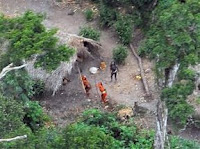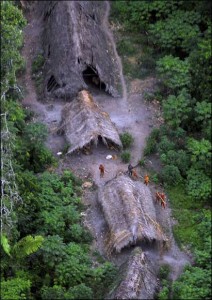 |
There has been a lot of press lately about the discovery of a previously uncontacted tribe along the Peru-Brazil border. There are pictures of a village from the air, with painted indigenes aiming their arrows at the airplane. Quaint, childlike Indians! There is a rush now to protect them, like an exotic threatened species, the way we protect the rainforest itself, for our future use.
For five hundred years, the Amazon has been one of those “dark unruly spaces of the earth” — the phrase is that of postcolonial theorist Homi K. Bhabha — that serve as a Rorschach test of the European imagination. The jungle, in the words of Candace Slater, a specialist in Brazilian literature, is “an emphatically nonparadisal space.” Novelist Barbara Kingsolver describes the jungle like this:
The trees are columns of slick, brindled bark like muscular animals overgrown beyond all reason. Every space is filled with life: delicate, poisonous frogs war-painted like skeletons, clutched in copulation, secreting their precious eggs onto dripping leaves. Vines strangling their own kin in the everlasting wrestle for sunlight. The breathing of monkeys. A glide of snake belly on branch. A single-file army of ants biting a mammoth tree into uniform grains and hauling it down to the dark for their ravenous queen. And, in reply, a choir of seedlings arching their necks out of rotted tree stumps, sucking life out of death. The forest eats itself and lives forever.
Every space is filled with life, she says — poisonous, ravenous, copulating, strangling, biting, sucking. Poet and naturalist Diane Ackerman speaks of the rainforest as a “world of cunning and savage trees,” where she finds “a vibrant aqua-blue-and-yellow arrowhead frog” covered with poisonous mucus, “tiny but pungent with death.” German filmmaker Werner Herzog, who filmed both Aguirre, the Wrath of God and Fitzcarraldo in the rainforest west of Iquitos, says the jungle is “fornication and asphyxiation and choking and fighting for survival and growing and just rotting away.” These are the tropes of the jungle in the European imagination: the jungle is disordered growth, unrestrained, sexual; the jungle is rank decay, cunning, savage, poisonous.
But there is also another jungle in the European imagination — Edenic, virginal, source of medicines. If the word jungle, with its connotations of dense impenetrability, is the key term for the savage wilderness, the word rainforest is the key term for the Edenic wilderness. Since the 1970s, the tropical rainforest has become the most powerful modern icon of unfallen, pristine, sacred land, acquiring ever stronger Edenic overtones, and has become increasingly synonymous with Amazonia; so positive is its connotation that the adjective rainforest has become a marketing tool for cosmetics, theme restaurants, “ruggedly elegant outerwear,” and gourmet ice cream. The rainforest is beautiful and radiant, a living cathedral enshrined in sumptuous coffee table books. But while the rainforest is beautiful, it is intensely vulnerable. Thus the jungle is savage and must be tamed; the rainforest is fragile and must be preserved. In either case, the land requires the intervention of European attitudes and technologies.
 |
Here is an example, related by Candace Slater. During the early 1990s, McDonald’s Corporation put out a brochure describing the company’s rainforest policy, featuring a photograph of a shimmering grove, bright light slanting through tall trees, bare trunks soaring to the sky. The problem is that the photograph is not of a rainforest at all, but rather another kind of woodland — “actually temperate conifers completely alien to the tropics,” notes Slater. A real rainforest, with parasitic lianas and epiphytes covering the trees, the canopy blocking the sky, was apparently insufficiently radiant for corporate advertising purposes.
In any current dialogue regarding tropical forests, the Amazon Basin is usually mentioned as a vital area to be left untouched and protected; yet archeological, historical, and ecological evidence increasingly shows not only a high density of human populations in the past but also an intensively managed and constantly changing environment as well. In much of Amazonia, it is difficult to find soils that are not studded with charcoal — clearly the result of human slash-and-burn agriculture. People have have been in the rainforest for a long time, and have been actively managing their environment as well, with nothing primitive about it.
Rainforest environmentalism sees the rainforest native as sharing the purity of the rainforest — closer to nature, less affected by the evils of the world, demonstrating the integrity of the unspoiled. The native of the rainforest is a monolithic figure, the keeper and companion of the plants and animals, an instrument to criticize our own civilization. That purity becomes associated with a wisdom we once had but have lost, and which we need to recover in order to rebuild what our technology has destroyed. Thus, the native is our guide — “our guide to nature, or our guide to the prehistoric past,” as anthropologist Bernard McGrane ironically puts it. This wisdom of the rainforest was therefore ours all along, and stands ready to be reappropriated by the dominant culture.

- Previous Post: Hallucinogens in Africa
- Next Post: Endogenous Dimethyltryptamine
- More Articles Related to: Indigenous Culture, The Amazon



I am glad to see the return of your blog’s posting. Great article to start it again with, as well. Well done.
Excellent post Steve. It seems that the rainforest, like shamanism, is full of the projections and fantasies of the viewer or reporter. I recently took another approach to current sensational media about Indians and Amazônia here.
Yes, there’s tremendous media distortion about both indigenous peoples and nature’s ecologies. The “lost tribe” stories are a case-in-point. While these tribes are “uncontacted” they have been known for a long time. The original news stories were quite fair about this, for example: AP but as the “Lost Tribe” meme gained media currency, the British newspaper THE OBSERVER played the photos out as a “hoax” causing a new round of sensational stories and a most unfortunate attack on the credibility of the outstanding NGO Survival International. Their defense is here. All of this confirms (I believe) the basic drift of Steve’s post.
One small quibble: I have little doubt of cited MacDonald’s misrepresentations but it’s important also to note that rain forests are not only tropical. The North American Pacific Northwest is full of the temperate version and they are loaded with conifers.
All best,
lou
VISIONSHARE blog